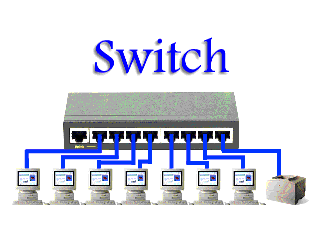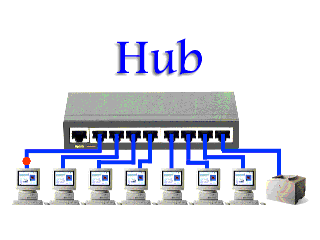In most cases, a network switch performs the same as a hub. They are both able to transmit data from one computer to another. For an Ethernet switch, it is sometimes called a hub. In other cases, some people prefer to use these two terms to refer to a box for their similar appearance. Actually, there are great differences between hub vs switch. In order to differentiate them, we will introduce some basics and applications of Ethernet hub vs switch.
The Basics of an Ethernet Switch
An Ethernet switch is commonly regarded as a multi-port network bridge. That’s because it processes and routes data on a data link layer (layer 2) and sometimes network layer (layer 3) of the OSI model. As an intelligent device, the Ethernet Gigabit switch transmits data to specific MAC addresses within the LAN. It has the capability to spot and distinguish specific addresses by accessing them from a CAM table. Besides, the switch can do everything a hub does with higher efficiency, including recognizing the intended destination of the source information that they receive.
The Basics of a Hub
Conventionally, a hub works on the physical layer or layer 1 of the Open Systems Interconnection (OSI) model. It connects multiple Ethernet devices on one network. Then making all these devices work together as a single network. The hub does not examine the data it receives or sends. Thus, when a packet arrives at one port, it is just copied to the other ports and seen by all segments of the LAN.
Ethernet Hub vs Switch: Which One Should I Buy?
Hub was initially popular due to the high price of Gigabit switch. However, a switch is not so expensive these days. And hubs are gradually becoming obsolete in some occasions. Anyhow, they are still useful in special circumstances. Application comparisons between Ethernet hub vs switch have been listed as below:
- For small-sized families, a hub is the least expensive way to construct a network connecting personal computers together. When it refers to the Gigabit switch, an 8 port Gigabit switch is a structured wiring solution designed to satisfy this need.
- People will benefit a lot from an Ethernet switch from some home networking. For example, with four or more computers, they need applications that can generate significant amounts of network traffic, such as multiplayer games or heavy music file sharing. By generating less network traffic in delivering messages, the Ethernet switch performs better than a hub in busy networks.
- For a small network with lesser users or devices, a hub can easily deal with network traffics. It will be a cheaper option for a network cabling. While the network grows larger with about 50 users, it is better to use an Ethernet switch to cut down the unnecessary traffic.
- If the performance monitor presents network bottlenecks or a congested network, an Ethernet switch will be used for its increased performance. Working with both hubs and switches in a producing environment is important.
Conclusion
Generally, the Ethernet hub vs switch is used in the same network. A hub extends the network by providing more ports. While an Ethernet switch divides the network into smaller, less congested divisions. You can choose to buy Ethernet switch or hub according to your different demands. For the best Ethernet switch, FS would be your perfect choice.
Related Article: Data Switch vs Hub in a Home Network
What’s the Difference: Hub vs Switch vs Router






